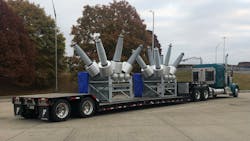The move to zero-emission trucking is one that will happen over the course of several decades. However, some leasing companies and fleets are beginning the journey now. Speaking at a recent NationaLease meeting, Mike Oliver, vice president of operations at Velocity Truck Rental & Leasing, and Andy Lewis, its director of asset management, shared lessons learned from their electrification experience which began in 2018.
At that time, they acquired four Mitsubishi Fuso eCanters and began installing chargers at its Fontana, California location. In 2020, the company installed chargers at its Rancho Dominguez, California, location. Earlier this year they took delivery of five Freightliner eCascadias that are on a five-year lease to a customer.
See also: Daimler, Toyota strike deal to merge Fuso and Hino
Velocity has been working with Edison Energy to implement an electric vehicle charging infrastructure for Class 6 to 8 vehicles.
Oliver and Lewis shared the steps it used while working with Edison Energy to get its charging infrastructure in place.
- Integrating fleet operations with charging strategies: Analyze how you use your vehicles to develop a strategy and site layout for charging that doesn't interfere with your existing operations.
- Charging infrastructure and technology selection: Determine the proper electric vehicle supply equipment (EVSE) requirements to assure the selected infrastructure is right for your location’s charging needs.
- Utility and permitting coordination: Work with utilities and authorities having jurisdictions (AHJ) for timely utility connection and permit authorization to ensure smooth timelines.
- Incentive and funding program management: Identify and navigate the application process for incentive and additional funding opportunities that can offset the cost of your vehicles and charging infrastructure.
- Site planning and EVSE design: Conduct on-site assessments of sites for optimal EVSE conceptual site layout, operational needs, and charging strategy.
- Construction: Oversee EVSE project engineering, design, and construction to maintain high-quality work with minimum site disruption.
- High-power utility service connections: Determine methods of service for multimegawatt projects including medium-voltage service connection with client-owned distribution systems if necessary.
- Aligning vehicle delivery and charging transition plans: Create a phased charging plan to ensure EVSE procurement and construction are aligned with vehicle delivery schedules to avoid vehicle downtime.
They also shared best practices to follow when installing EV charging infrastructure.
- Perform an on-site assessment to determine the optimal site layout and charging strategy. This process should include reviewing the scope and desired outcomes of the projects at each site.
- Study vehicle operations for each project site to ensure full operational accessibility of the fleet yard, while matching infrastructure location to charge ports.
- Perform a thorough review of vehicle, operational, and utility needs to determine ideal EVSE requirements and identify a select pool of EVSE manufacturers and charge management software (CMS) providers that have products capable of meeting your needs.
- Smart site design allows for efficient utilization of charger locations while allowing for optimal fleet operations and future growth. This should include working with the utilities early for designs that have the capability for future expansion.
- Modular charging hardware needs to be considered that has a more efficient footprint and allows for variable speed charging and the capability to serve additional future loads as the charging infrastructure expands.
- Engineered site designs should be done in parallel with utility engagement, permitting, utility interconnection, and incentive applications. This will save months of deployment time for projects.
Velocity’s electric journey is at the beginning stages and by the end of this year, it plans to have 30 EVs in operation—25 eCascadias and 5 eM2s. In the next two years, the plan is to have 200 EVs in operation which will be a mix of eCascadias, eM2s, and all-new Velocity Vehicle Group exclusive Rizon trucks for the Class 4 and 5 market.
Consider following these guidelines and best practices as you begin to add EVs to your operation.
Jane Clark is vice president of member services for NationaLease. In this position, she is focused on managing the member services operation as well as working to strengthen member relationships, reduce member costs, and improve collaboration within the NationaLease supporting groups. Prior to joining NationaLease, Clark served as area vice president for Randstad, one of the nation’s largest recruitment agencies, and before that, she served in management posts with QPS Cos., Pro Staff, and Manpower Inc.
About the Author
Jane Clark
Senior VP of Operations
Jane Clark is the senior vice president of operations for NationaLease. Prior to joining NationaLease, Jane served as the area vice president for Randstad, one of the nation’s largest recruitment agencies, and before that, she served in management posts with QPS Companies, Pro Staff, and Manpower, Inc.
